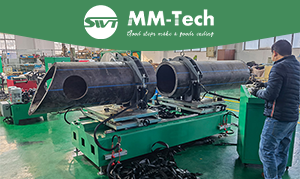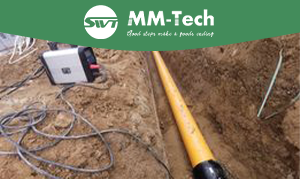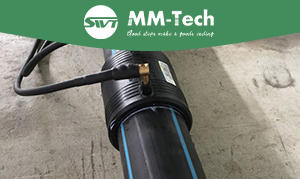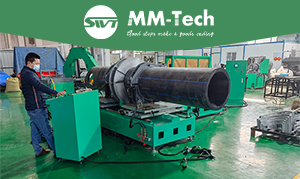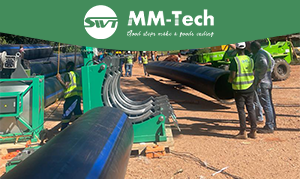Choosing the right welding method for HDPE pipes depends on factors like pipe size, project complexity, and budget. The hdpe pipe butt fusion welding machine works best for large pipes, offering seamless joints and durability. Electrofusion excels in confined spaces and complex networks. Increasing demand for reliable piping systems highlights the importance of both methods in modern infrastructure.
Key Takeaways
Butt fusion welding works well for big pipes. It makes strong, smooth joints for high-pressure use.
Electrofusion welding is great in small spaces. It gives accurate and flexible connections for tricky pipe setups.
Think about project needs, cost, and site limits when picking between butt fusion and electrofusion for HDPE pipe welding.
What is Butt Fusion Welding?
How Does Butt Fusion Work?
Butt fusion welding is a reliable method for joining polyethylene pipes. It involves a step-by-step process to ensure strong and durable joints. First, you clean the pipe ends to remove dirt and oxidized material. Next, you align the pipes using a fusion machine to ensure proper positioning. A heated plate then melts the pipe ends to the correct temperature. Once melted, you press the ends together under controlled pressure to create a seamless bond. Afterward, you allow the joint to cool while maintaining pressure. Finally, you inspect the weld for uniformity and defects to confirm its quality. This process ensures a joint that is as strong as the original pipe material.
Applications of Butt Fusion in HDPE Pipe Joining
Butt fusion welding has a wide range of applications in industries that use HDPE pipes. It is commonly used in water supply systems due to its ability to withstand high pressure. Gas supply networks also benefit from this method because of its leak-proof joints and resistance to chemical corrosion. In sewage systems, it handles harsh environmental conditions effectively. Additionally, industries like mining and agriculture rely on it for robust and flexible piping systems. These applications highlight the versatility of this welding method.
Advantages of Using a Butt Fusion Machine
Using a butt fusion machine offers several advantages. It allows you to join pipes of various sizes and thicknesses, making it suitable for high-pressure applications like gas and water supply. The joints created are watertight and maintain the pipe’s strength and integrity. Portable machines enhance usability in remote locations, making them ideal for fieldwork. Properly executed butt fusion achieves efficiency levels close to 95%, ensuring reliable and durable connections.
Why Choose MM-Tech’s HDPE Pipe Butt Fusion Welding Machine?
MM-Tech’s HDPE pipe butt fusion welding machine stands out for its advanced features and robust design. It uses intelligent matching capabilities and cartridge valve systems for precise pressure regulation. These features ensure high-quality joints and enhance usability. The machine’s anti-stick Teflon-coated heating plate and stable trimmer tool improve operational efficiency. Its ability to upgrade with a data logger allows you to monitor and record welding parameters, ensuring compliance with industry standards. MM-Tech’s machine combines durability, precision, and user-friendly design, making it a top choice for joining polyethylene pipes.
What is Electrofusion Welding?
How Does Electrofusion Work?
Electrofusion welding, also known as electric fusion welding, is a precise method for joining HDPE pipes. You follow a step-by-step process to ensure strong and reliable joints:
Gather supplies, including HDPE pipes, electrofusion fittings, a welding machine, and personal protective equipment (PPE).
Prepare the pipe ends by cutting them square, deburring, and cleaning the surfaces.
Inspect the fitting for defects and confirm compatibility with the pipe.
Align the fitting over the pipe ends, ensuring proper positioning.
Connect the electrodes to the electrofusion machine as per the instructions.
Input the required fusion parameters, such as temperature and time, based on the manufacturer’s guidelines.
Start the heating cycle and monitor the process closely.
Allow the joint to cool completely without interference.
Conduct a final inspection and pressure test to verify the joint’s integrity.
Record all process details for future reference.
This method ensures a durable and leak-proof connection, making it ideal for critical applications.
Applications of Electrofusion in HDPE Pipe Joining
Electrofusion plays a vital role in HDPE pipe installations. It is especially useful in situations requiring precision and reliability. You can use it in confined spaces without needing external heat sources. This method accommodates different pipe diameters and integrates well with automated systems. Common applications include:
Water supply systems, where leak-free joints are essential.
Gas distribution networks, benefiting from its accuracy and strength.
Complex piping setups, where traditional methods may not work.
Electrofusion couplers simplify the process by eliminating the need for flanges or clamps, making them versatile for various industries.
Advantages of Electrofusion Welding
Electrofusion welding offers several advantages that make it a preferred choice for HDPE pipe joining.
Advantage | Description |
|---|---|
Suitability for complex installations | Ideal for intricate setups where precision is crucial. |
No external heat sources | Convenient for small or isolated areas. |
Compatibility with different diameters | Allows connections between pipes of varying diameters, enhancing versatility. |
Additionally, this method provides leak-free joints and simplifies the process, accommodating various pipe diameters and wall thicknesses.
Features of MM-Tech’s Electrofusion Welding Machine
MM-Tech’s electrofusion welding machine stands out for its advanced features and robust design. It uses intelligent matching capabilities and cartridge valve systems for precise pressure regulation. The machine adapts to a wide voltage range, ensuring stability even in challenging environments. Its high-brightness LCD display supports both Chinese and English, making it user-friendly. You can store welding records and export data via USB, enhancing traceability. MM-Tech also offers a two-year warranty, reflecting their commitment to quality and customer satisfaction.
Comparing Butt Fusion and Electrofusion
Joint Strength and Durability
When considering joint strength, butt fusion welding creates a seamless and strong connection. The joint becomes as durable as the original pipe material, making it suitable for high-pressure applications. Electrofusion, on the other hand, relies on the quality of the fittings used. While it provides reliable connections, its strength may vary depending on the fitting’s manufacturing standards. For projects requiring a strong and homogeneous joint, butt fusion offers a more consistent solution.
Cost Efficiency for HDPE Pipe Joining Methods
Cost plays a significant role in choosing between these methods. Butt fusion is more economical for large-scale projects since it eliminates the need for additional fittings. Electrofusion, however, involves higher equipment cost due to specialized fittings, which can increase the overall expense. Despite this, it may save time and labor in complex installations, making it a cost-effective choice for intricate setups. Evaluating your budget and project requirements will help you decide the most suitable option.
Flexibility and Accessibility in Different Environments
Electrofusion excels in confined spaces and challenging environments. You can perform it with minimal equipment, making it less affected by weather conditions. Butt fusion, while suitable for larger pipes, requires more space and additional tools like a generator and shelter. This limits its use in tight or remote areas. For projects with accessibility constraints, electrofusion welding offers greater flexibility.
Skill and Equipment Requirements
Butt fusion demands skilled operators to ensure proper heating, alignment, and pressure during the process. It also requires specialized equipment, including heating plates and hydraulic clamps. Electrofusion, in contrast, is more user-friendly and suitable for less experienced personnel. Its equipment includes a welding machine and fittings with built-in heating elements. If you prioritize ease of use, electrofusion may be the better choice.
Environmental Suitability and Site Conditions
Electrofusion adapts well to adverse site conditions. Its process is less affected by weather, making it ideal for outdoor or remote installations. Butt fusion, however, requires controlled conditions to maintain welding quality. For projects in harsh environments, electrofusion provides a reliable and efficient solution.
Choosing the Best Method for Your Project
Key Factors to Consider
Selecting the most suitable method for HDPE welding involves evaluating several critical factors. These considerations ensure you achieve the best results for your project:
Factor | Description |
|---|---|
Project Requirements | Specifications such as pipe diameter, material compatibility, joint configuration, and welding speed. |
Cost Considerations | Initial equipment investment, ongoing maintenance costs, and labor requirements. |
Quality and Reliability | Strong and durable fusion joints depend on operator skill, welding conditions, and environmental factors. |
Efficiency and Productivity | Efficiency based on project timeline, labor availability, and desired welding speed. |
Compatibility | Availability of compatible components for specific needs. |
Additionally, you should assess pipe size, budget, accessibility, and required joint strength. Large-diameter pipes often favor butt fusion due to its seamless joints and cost-effectiveness. Electrofusion, however, excels in confined spaces or when working with dissimilar pipe sizes. Consider the availability of skilled labor and equipment to ensure smooth execution.
Tip: Consulting experts like MM-Tech can simplify this decision. Their advanced machines, exceptional customer support, and innovative technologies ensure project success.
Common Scenarios and Recommendations for HDPE Welding
Understanding common use cases can help you decide between these methods. Butt fusion is ideal for large-scale projects involving long-distance pipelines. It works best for applications requiring high joint strength, such as gas or pe water supply pipes. Open workspaces suit this method well, as it requires more space for equipment operation.
Electrofusion welding, on the other hand, is better for intricate setups or repairs in tight spaces. It offers versatility for joining pipes of varying diameters and performs reliably in harsh environments. For projects with limited accessibility or adverse weather conditions, this method provides a practical solution.
Best Practices: Follow industry guidelines to ensure optimal results. For example, butt fusion demands precise temperature control, while electrofusion requires high-quality fittings for durable joints.
By aligning your project needs with these recommendations, you can confidently choose the best method for your HDPE welding tasks.
Both butt fusion and electrofusion provide reliable solutions for HDPE pipe welding. Your choice depends on project-specific needs like pipe size, location, and budget. The table below highlights key differences to help you make an informed decision:
Aspect | Electrofusion Fittings | Butt Fusion Fittings |
|---|---|---|
Connection Method | Utilizes embedded resistance wires; heats only the inner surface. | Heats entire end face using a heating plate. |
Construction Process | Highly automated; lower alignment requirements. | Requires precise control and alignment. |
Equipment Requirements | Small, portable machines with low power consumption. | Larger machines with higher power requirements. |
Application Scenarios | Best for small-diameter pipes and complex connections. | Ideal for large-diameter main pipelines. |
Cost | Generally higher manufacturing and equipment costs. | Typically lower costs for fittings and equipment. |
MM-Tech offers advanced butt fusion and electrofusion machines to meet diverse project requirements. Consult their experts or follow industry guidelines to ensure optimal results.
FAQ
What is the main difference between butt fusion and electrofusion welding?
Butt fusion joins pipes by melting their ends, creating a seamless bond. Electrofusion uses fittings with embedded heating elements to fuse pipes, offering precision in confined spaces.
Can you use both methods for the same project?
Yes, you can combine both methods. Use butt fusion for large pipelines and electrofusion for intricate connections or repairs in tight spaces.
How do you ensure a successful weld?
Follow proper preparation steps, including cleaning and aligning pipes. Use high-quality equipment like MM-Tech machines. Monitor parameters like temperature and pressure for consistent results.


